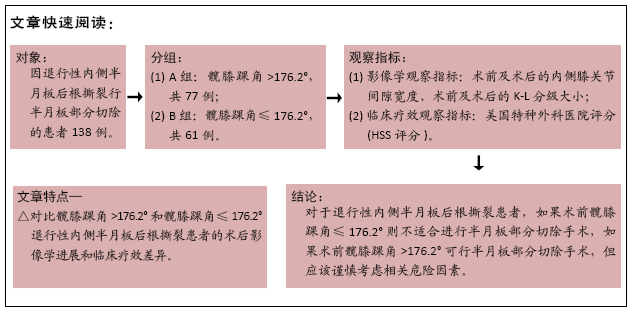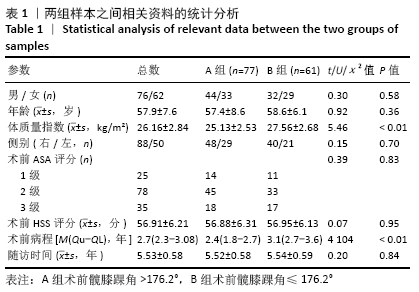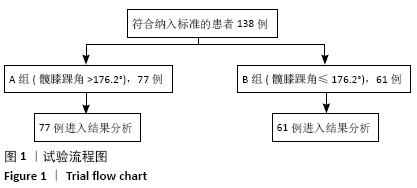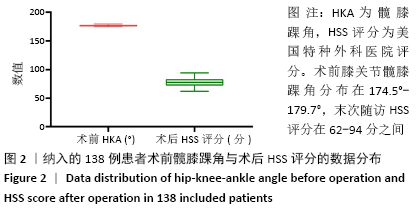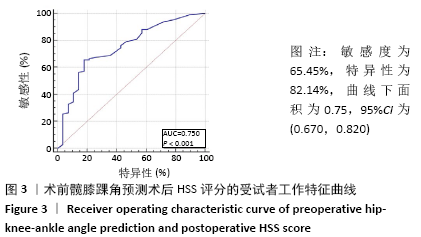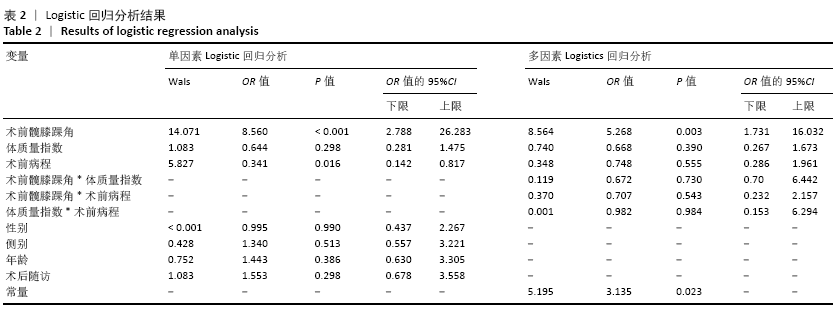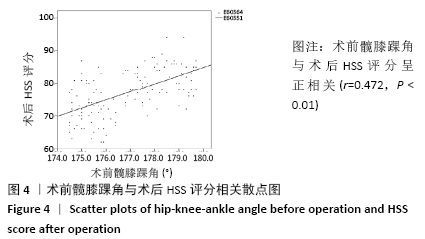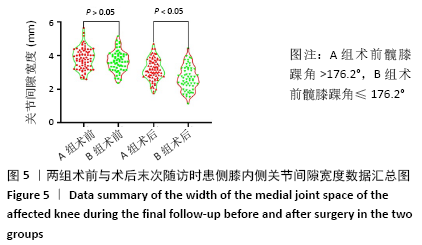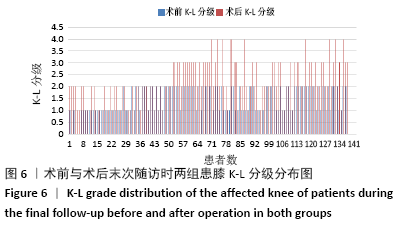[1] BIN SI, KIM JM, SHIN SJ. Radial tears of the posterior horn of the medial meniscus. Arthroscopy. 2004;20:373-378.
[2] KAPLAN DJ, ALAIA EF, DOLD AP, et al. Increased extrusion and ICRS grades at 2-year follow-up following transtibial medial meniscal root repair evaluated by MRI. Knee Surg Sports Traumatol Arthrosc. 2018;26:2826-2834.
[3] KE XI, QIU J, CHEN S, et al. Concurrent arthroscopic meniscal repair during open-wedge high tibial osteotomy is not clinically beneficial for medial meniscus posterior root tears. Knee Surg Sports Traumatol Arthrosc. 2020. doi: 10.1007/s00167-020-06055-9.
[4] LEE JH, LIM YJ, KIM KB, et al. Arthroscopic pullout suture repair of posterior root tear of the medial meniscus: radiographic and clinical results with a 2-year follow-up. Arthroscopy. 2009;25:951-958.
[5] OKAZAKI Y, FURUMATSU T, SHIMAMURA Y, et al. Time-dependent increase in medial meniscus extrusion after medial meniscus posterior root tear analyzed by using magnetic reso-nance imaging. Knee Surg Relat Res. 2019;31:120-125.
[6] KIM SB, HA JK, LEE SW, et al. Medial meniscus root tear refixation: comparison of clinical, radiologic, and arthroscopic findings with medial meniscectomy. Arthroscopy. 2011;27:346-354.
[7] BERNARD CD, KENNEDY NI, TAGLIERO AJ, et al. Medial menis-cus posterior root tear treatment: a matched cohort comparison of nonoperative management, partial meniscectomy, and repair. Am J Sports Med. 2020;48(1):128-132.
[8] PARK DY, MIN BH, CHOI BH, et al. The degeneration of meniscus roots is accompanied by fbrocartilage formation, which may precede meniscus root tears in osteoarthritic knees. Am J Sports Med. 2015;43:3034-3044.
[9] HAN SB, SHETTY GM, LEE DH, et al. Unfavorable results of partial meniscectomy for complete posterior medial meniscus root tear with early osteoarthritis: a 5-to 8-year follow-up study. Arthroscopy. 2010;26:1326-1332.
[10] OZKOC G, CIRCI E, GONC U, et al. Radial tears in the root of the posterior horn of the medial meniscus. Knee Surg Sports Traumatol Arthrosc. 2008;16:849-854.
[11] KRYCH AJ, JOHNSON NR, MOHAN R, et al. Partial meniscectomy provides no benefit for symp-tomatic degenerative medial meniscus posterior root tears. Knee Surg Sports Traumatol Arthrosc. 2018;26: 1117-1122.
[12] LEE BS, BIN SI, KIM JM, et al. Partial meniscectomy for degenerative medial meniscal root tears shows favorable outcomes in well-aligned, nonarthritic knees. Am J Sports Med. 2019;47:606-611.
[13] MOATSHE G, CHAHLA J, SLETTE E, et al. Posterior meniscal root injuries. Acta Orthop. 2016;87:452-458.
[14] 史俊龙,鹿战,雷宏伟,等.下肢力线在盘状半月板损伤应用的研究进展[J].中国骨伤,2020,33(4):383-387.
[15] JOHN R, MORELAND A, LAWRENCE W, et al. Radio graphit analysis of the axial alignment of the lower extremity. J Bone Joint Surg. 1987;11: 745-749.
[16] MORELAND JR, BASSETT LW, HANKER GJ. Radiographic analysis of the axial alignment of the lower extremity. J Bone Joint Surgery Am. 1987;69(5):745-749.
[17] Hellio Le Graverand MP, Mazzuca S, Duryea J, et al. Radio graphic grading and measurement of joint space width in osteoarthritis. Rheum Dis Clin North Am. 2009;35:485-502.
[18] 蒋美超.膝关节单髁置换术影像学及临床疗效评估[D].石家庄:河北医科大学,2011.
[19] ALLEN CR, WONG EK, LIVESAY GA, et al. Impor-tance of the medial meniscus in the anterior cruciate ligament deficient knee. J Orthop Res. 2000;18(1):109-115.
[20] MUSAHL V, CITAK M, O’LOUGHLIN PF, et al. The effect of medial versus lateral meniscectomy on the stability of the anterior cruciate ligament–deficient knee. Am J Sports Med. 2010;38(8):1591-1597.
[21] PAPAGEORGIOU CD, GIL JE, KANAMORI A, et al. The biomechanical interdependence between the anterior cruciate ligament replacement graft and the medial meniscus. Am J Sports Med. 2001;29(2):226-231.
[22] SPANG JT, DANG AB, MAZZOCCA A, et al. The effect of medial meniscectomy and meniscal allograft transplantation on knee and anterior cruciate ligament biomechanics. Arthroscopy. 2010;26(2):192-201.
[23] ALLAIRE R, MURIUKI M, GILBERTSON L, et al. Biome chanical consequences of a tear of the posterior root of the medial meniscus. Similar to total meniscectomy. J Bone Joint Surg Am. 2008;90:1922-1931.
[24] KWAK YH, LEE S, LEE MC, et al. Large meniscus extru-sion ratio is a poor prognostic factor of conservative treatment for medial meniscus posterior root tear. Knee Surg Sports Traumatol Arthrosc. 2018;26:781-786.
[25] BHATIA S, LAPRADE CM, ELLMAN MB, et al. Meniscal root tears: signifcance, diagnosis, and treatment. Am J Sports Med. 2014;42:3016-3030.
[26] LEE DW, HA JK, KIM JG. Medial meniscus posterior root tear: a comprehensive review. Knee Surg Relat Res. 2014;26:125-134.
[27] SHARMA L, SONG J, FELSON DT, et al. The role of knee alignment in disease progression and functional decline in knee osteoarthritis. JAMA. 2001;286:188-195.
[28] CHUNG KS, HA JK, YEOM CH, et al. Comparison of clinical and radiologic results between partial meniscectomy and refxation of medial meniscus posterior root tears: a minimum 5-year follow-up. Arthroscopy. 2015;31:1941-1950.
[29] FEUCHT MJ, KUHLE J, BODE G, et al. Arthroscopic transtibial pullout repair for posterior medial meniscus root tears: a systematic review of clinical, radiographic, and second-look arthroscopic results. Arthroscopy. 2015;31:1808-1816.
[30] CHUNG KS, HA JK, RA HJ, et al. Prognostic factors in the midterm results of pullout fxation for posterior root tears of the medial meniscus. Arthroscopy. 2016;32:1319-1327.
[31] BENICHOU OD, HUNTER DJ, NELSON DR, et al. One-year change in radiographic joint space width in patients with unilateral joint space narrowing: data from the osteoarthritis initiative. Arthritis Care Res. 2010;62:924-931. |
